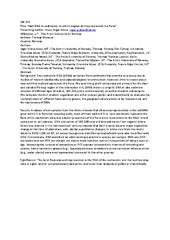Blar i forfatter Norges arktiske universitetsmuseum "Coissac, Eric"
-
A 2-million-year-old ecosystem in Greenland uncovered by environmental DNA
Kjær, Kurt H.; Winther Pedersen, Mikkel; De Sanctis, Bianca; De Cahsan, Binia; Korneliussen, Thorfinn S.; Michelsen, Christian S.; Sand, Karina K.; Jelavić, Stanislav; Ruter, Anthony H.; Schmidt, Astrid M. A.; Kjeldsen, Kristian K.; Tesakov, Alexey S.; Snowball, Ian; Gosse, John C.; Alsos, Inger Greve; Wang, Yucheng; Dockter, Christoph; Rasmussen, Magnus; Jørgensen, Morten E.; Skadhauge, Birgitte; Prohaska, Ana; Kristensen, Jeppe Å.; Bjerager, Morten; Allentoft, Morten E.; Coissac, Eric; Rouillard, Alexandra; Simakova, Alexandra; Fernandez-Guerra, Antonio; Bowler, Chris; Macias-Fauria, Marc; Vinner, Lasse; Welch, John J.; Hidy, Alan J.; Sikora, Martin; Collins, Matthew J.; Durbin, Richard; Larsen, Nicolaj K.; Willerslev, Eske (Journal article; Tidsskriftartikkel; Peer reviewed, 2022-12-07)Late Pliocene and Early Pleistocene epochs 3.6 to 0.8 million years ago had climates resembling those forecasted under future warming. Palaeoclimatic records show strong polar amplification with mean annual temperatures of 11–19 °C above contemporary values. The biological communities inhabiting the Arctic during this time remain poorly known because fossils are rare. Here we report an ancient ... -
High resolution ancient sedimentary DNA shows that alpine plant diversity is associated with human land use and climate change
Garces Pastor, Sandra; Alsos, Inger Greve; Coissac, Eric; Lavergne, Sébastien; Schwörer, Christoph; Theurillat, Jean-Paul; Heintzman, Peter D.; Wangensteen, Owen S.; Tinner, Willy; Rey, Fabian; Heer, Martina; Rutzer, Astrid; Walsh, Kevin; Lammers, Youri; Brown, Antony G.; Goslar, Tomasz; Rijal, Dilli P.; Karger, Dirk N.; Pellissier, Loïc; Heiri, Oliver (Journal article; Tidsskriftartikkel; Peer reviewed, 2022-11-04)The European Alps are highly rich in species, but their future may be threatened by ongoing changes in human land use and climate. Here, we reconstructed vegetation, temperature, human impact and livestock over the past ~12,000 years from Lake Sulsseewli, based on sedimentary ancient plant and mammal DNA, pollen, spores, chironomids, and microcharcoal. We assembled a highly-complete local DNA ... -
Macro-nutritional balancing in a circumpolar boreal ruminant under winter conditions
Spitzer, Robert; Coissac, Eric; Cromsigt, Joris P. G. M.; Felton, Annika M.; Fohringer, Christian; Landman, Marietjie; Neumann, Wiebke; Raubenheimer, David; Singh, Navinder; Taberlet, Pierre Robert Michel; Widemo, Fredrik (Journal article; Tidsskriftartikkel; Peer reviewed, 2023-02-08)<ol> <li>Differences in botanical diet compositions among a large number of moose faecal samples collected during winter correlated with the nutritional differences identified in the same samples (Mantel-r = 0.89, p = 0.001), but the nutritional differences were significantly smaller (p < 0.001).</li> <li>Nutritional geometry revealed that moose mixed Scots pine Pinus sylvestris and Vaccinium spp. ... -
Plant DNA in sediments: to which degree do they represent the flora?
Alsos, Inger Greve; Coissac, Eric; Edwards, Mary E.; Merkel, Marie Kristine Føreid; Gielly, Ludovic; Sjögren, Per; Taberlet, Pierre; Yoccoz, Nigel Gilles (Conference object; Konferansebidrag, 2015-05) -
Postglacial species arrival and diversity buildup of northern ecosystems took millennia
Alsos, Inger Greve; Rijal, Dilli Prasad; Ehrich, Dorothee; Karger, Dirk Nikolaus; Yoccoz, Nigel; Heintzman, Peter D.; Brown, Antony; Lammers, Youri; Pellissier, Loïc; Alm, Torbjørn; Bråthen, Kari Anne; Coissac, Eric; Merkel, Marie Føreid; Alberti, Adriana; Denoeud, France; Bakke, Jostein (Journal article; Tidsskriftartikkel; Peer reviewed, 2022-09-28)What drives ecosystem buildup, diversity, and stability? We assess species arrival and ecosystem changes across 16 millennia by combining regional-scale plant sedimentary ancient DNA from Fennoscandia with near-complete DNA and trait databases. We show that postglacial arrival time varies within and between plant growth forms. Further, arrival times were mainly predicted by adaptation to temperature, ... -
Sedimentary ancient DNA from Lake Skartjørna, Svalbard: Assessing the resilience of arctic flora to Holocene climate change
Alsos, Inger Greve; Sjögren, Per Johan E.; Edwards, Mary E.; Landvik, Jon Y.; Gielly, Ludovic; Forwick, Matthias; Coissac, Eric; Brown, Antony G; Jakobsen, Leif Vidar; Merkel, Marie Kristine Føreid; Pedersen, Mikkel Winter (Journal article; Tidsskriftartikkel; Peer reviewed, 2015-11-11) -
Shotgun-sequencing of plant DNA: Selection og material and methods
Merkel, Marie Kristine Føreid; Pitelkova, Iva; Lammers, Youri; Coissac, Eric; Alberti, Adriana; Dossat, Carole; Kirchefer, Andreas; Alsos, Inger Greve (Conference object; Konferansebidrag, 2017)Initially, rbcLaand ITS2 were PCR amplified and Sanger sequenced for 564 species from 1900 specimens. To increase the amount of the genome covered, shotgun sequencing of 1670 species is in progress. Our Sanger analyses had a success rate of 74% and 85% for ITS2 and rbcLa, respectively. Overall success rate of Sanger sequencing decreased with later collection date in the year. Preliminary results of ... -
Small shrubs with large importance? Smaller deer may increase the moose-forestry conflict through feeding competition over Vaccinium shrubs in the field layer
Spitzer, Robert; Coissac, Eric; Felton, Annika M.; Fohringer, Christian; Juvany, Laura; Landman, Marietjie; Singh, Navinder J.; Taberlet, Pierre Robert Michel; Widemo, Fredrik; Cromsigt, Joris P. G. M. (Journal article; Tidsskriftartikkel; Peer reviewed, 2020-11-18)The moose (Alces alces) is a dominant large mammalian herbivore in the world’s boreal zones. Moose exert significant browsing impacts on forest vegetation and are therefore often at the centre of wildlife-forestry conflicts. Consequently, understanding the drivers of their foraging behaviour is crucial for mitigating such conflicts. Management of moose in large parts of its range currently largely ... -
Tempo and drivers of plant diversification in the European mountain system
Smyčka, Jan; Roquet, Cristina; Boleda, Martí; Alberti, Adriana; Boyer, Frédéric; Douzet, Rolland; Perrier, Christophe; Rome, Maxime; Valay, Jean-Gabriel; Denoeud, France; Šemberová, Kristýna; Zimmermann, Niklaus E.; Thuiller, Wilfried; Wincker, Patrick; Alsos, Inger Greve; Coissac, Eric; Lavergne, Sébastien (Journal article; Tidsskriftartikkel; Peer reviewed, 2022-05-18)There is still limited consensus on the evolutionary history of species-rich temperate alpine floras due to a lack of comparable and high-quality phylogenetic data covering multiple plant lineages. Here we reconstructed when and how European alpine plant lineages diversified, i.e., the tempo and drivers of speciation events. We performed full-plastome phylogenomics and used multi-clade comparative ...


 English
English norsk
norsk







